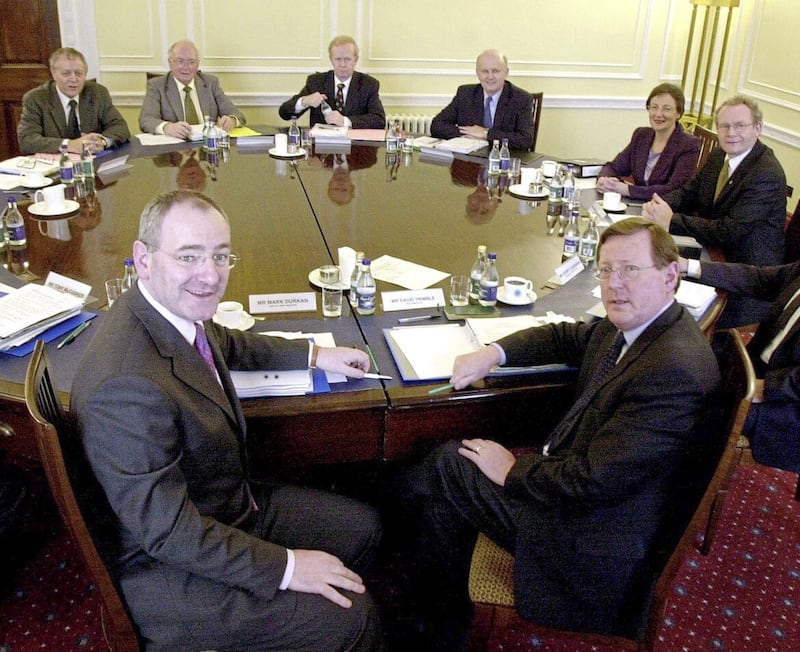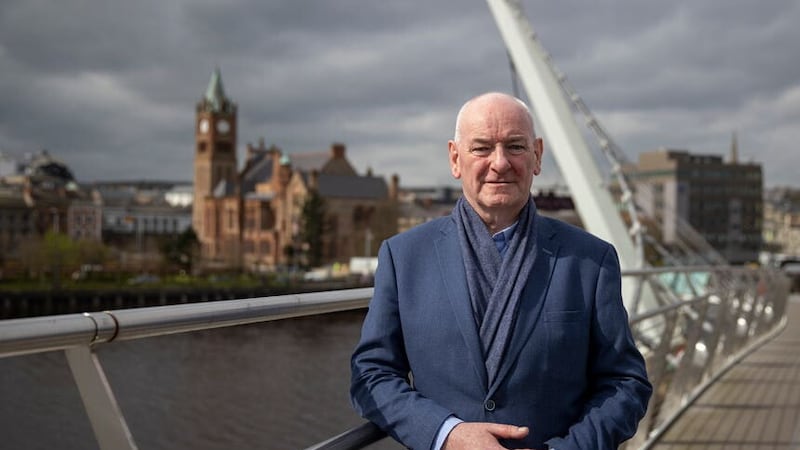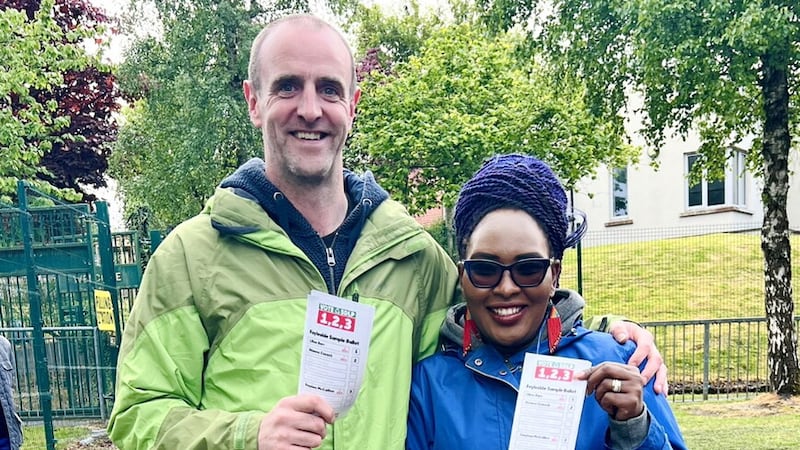THE BELFAST/Good Friday Agreement was achieved by negotiation. It was the product of political dialogue about different ideas for political institutions, differing constitutional aspirations and diverging views on rights and the promotion of equality. Its achievement – and more of its content than is acknowledged - rested on layers of understanding built up through earlier talks and texts whose standing might previously have been disputed or dismissed.
That dialogue was intentionally inclusive. Its agenda was supposed to be comprehensive so that it could address the three sets of relationships (as originally defined by John Hume), requirements for rights and equality and wider new beginnings that could mark a real transition from conflict. The agreed rules for those negotiations included the adoption of John Hume’s idea that any agreement should be subject to referendum, north and south, to ensure its legitimacy for unionists and nationalists respectively.
Tony Blair speaks to The Irish News to mark 25 years since the Good Friday Agreement
Taking in some media specials about the Agreement, I have to remind myself that these were multi-party negotiations covering constitutional, institutional and other contentious facets on which any agreement would have to be commended for democratic endorsement by very different parties.
I recall, at the talks table, speaking about “collective ambiguity” and parties needing to be honest about our likely differing emphases on the worth or potential of different provisions. That was at a stage when a cross-party agreement on a rounded package still seemed a remote prospect given the wide differences between stated positions.
On March 25, when George Mitchell set a deadline of April 9, parties were far apart.
Read More
- Tom Kelly: Celebrate GFA - now is not time for its epitaph (premium)
- Tony Blair says unionism needs a leader of David Trimble's courageousness
- Bríd Rodgers acknowledges flaws of past 25 years but has no regrets over peace
- Gerry Adams says risks taken for peace were 'occupational hazard'
- Lord Reg Empey says St Andrews was a 'catastrophe' for the Good Friday Agreement
The SDLP were still alone proposing an elective inclusion model where parties could be entitled by mandate to nominate ministers without being vetted or vetoed by others – parties could decline to appoint ministers so office would be a voluntary choice. Alliance were pushing a conventional voluntary coalition executive. The UUP were statedly opposed to having ministers and an executive in a new assembly. Sinn Féin were still refusing to submit positions on Strand One, denouncing devolution as a “partition solution”, arguing against any change to Articles 2 & 3 – they had covered the north with “No Return to Stormont” posters since January.
The UUP were also arguing at this stage that Strand Two should not even have its own political standing but merely work as a technocratic sub-strand of a 'Council of the Isles' in Strand Three. They attacked our elective inclusion model for Strand One with fears about rogue ministers, solo runs and democratic deficits. Meanwhile Sinn Féin chastised us for even envisaging an assembly.
Gerry Adams speaks to The Irish News to mark 25 years since the Good Friday Agreement
The term 'mandatory coalition' was coined by the DUP in opposing the Agreement. It was never used in the arguments for - or against - our proposals for ministers to be appointed under the D’Hondt formula. We resisted Alliance’s voluntary coalition model as that would entail the involuntary exclusion of a party or parties which would go against the essence of inclusion, which was the basis of the talks. We worried that an agreement based on voluntary coalition would have less appeal in the intentionally historic referendum if parties (and supporters) cast as likely to be kept out of government could feel compelled to adopt a 'No' stance.
To meet the various critiques from other parties of our idea for government formation by elective inclusion, we amplified accountability, scrutiny, collectivity and transparency features in our model. These included the 'petition of concern' device (shaped by John Alderdice and ourselves): not to be a veto but to trigger a special proofing procedure in respect of stated rights or equality concerns. The expansive outline remit which we drafted for assembly committees and the standards inherent in our proposed ministerial pledge of office were further dimensions.
With 'sufficient consensus' as a safeguard in the agreed rules for these negotiations, it was hardly surprising that it would also be reflected in the agreed institutional outcome. Whatever about parties’ different structural models - with or without ministers - there was general acceptance of the value of cross-community support being shown for strategic decisions like budgets.
We had to face a conundrum with our D’Hondt model. Would the first choice under the formula be the chief or first minister, with what remit in relation to other ministers and governance overall? Would the number two slot under D’Hondt have a deputy status in respect of the first position and would a bespoke remit be ascribed? The first and second parties in seat numbers might be from the same designation.
Reg Empey speaks to The Irish News to mark 25 years since the Good Friday Agreement
Alliance (still arguing for voluntary coalition) proposed that the first minister should come from the largest designation and should coordinate internal regional government; the second minister, from the second largest designation, should coordinate external relationships across government; and the speaker should be from the third largest designation.
Not only the SDLP were wary about creating such a hierarchy of designation. Nor did we believe that delineation between internal and external questions would be contention-free. We were not going to graft this Alliance suggestion onto our elective inclusion ideas.
Our answer was the idea of joint and equal first ministers who would be elected, with cross-community support, by the assembly as a reflection of its primacy and an answer to the democratic deficit complaints. That idea was inspired when I saw the pictures of David Trimble and Seamus Mallon in Poyntzpass on March 4. When I drafted an alphabetical list of possible role and functions of joint first ministers, my instructions from John and Seamus were to include fallback coordination roles for them in the event of the UUP still holding out against a collective executive.

It was on Friday March 27 that we showed David Trimble that list when we put the idea to him for the first time. He observed that it was written in the language of roles and functions and he would like to see more of it written in the language of power. When asked for an example of power, he replied “patronage”. While specifying that there should be differential titles for such joint and equal ministers, he still objected to the scope of elective inclusion and any "cabinet-style" ministerial body.
Slightly less than two weeks later, we used an arguable measure of patronage for the first and deputy first ministers to get his agreement to a Civic Forum as part of Strand One. This was alongside an executive committee, formed by elective inclusion with ministers also participating in a bespoke North-South Ministerial Council.
The essence of elective inclusion was to assure parties (and citizens/voters) that the right to be in government with sufficient mandate could not be vetoed - even by a combination of other parties. The current abeyance of the assembly is a complete contradiction of that precept. One party is now able to use an 'extend to all' veto, created by the St Andrews Agreement’s misguided terms, to frustrate the democratic mandates accorded last year to all parties and the assembly at large.
Brid Rodgers speaks to The Irish News to mark 25 years since the Good Friday Agreement








